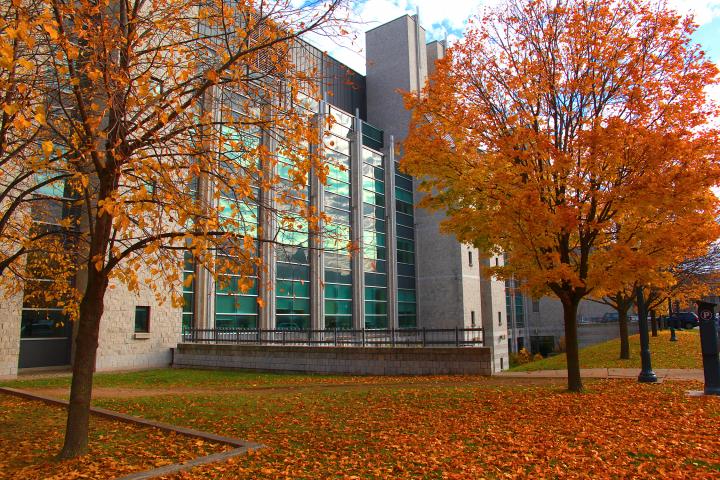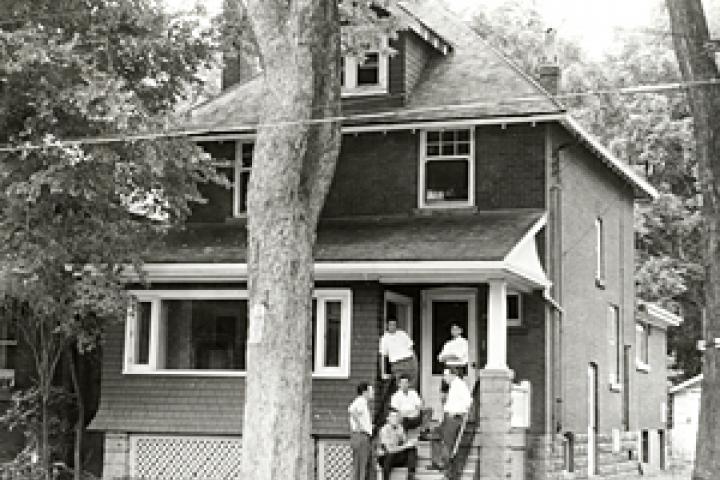Prof. Steve Lougheed (Biology) bustles into his office at the Queen’s University Biological Station (QUBS – or “Cubes,” as it’s known to the researchers and students who live and work there), and apologizes for being late.
“I was rescuing turtles,” he says. It’s mid-June, the time for female turtles – snappers, painted turtles, Blanding’s turtles – to crawl up from the wetlands and inch their way across busy roads to bury their eggs in the gravelly shoulders.
“Elbow Lake,” Lougheed says, “has the highest concentration of Blanding’s turtles I’ve ever seen.” As a geneticist and conservation biologist specializing in reptiles and amphibians, he’s seen a lot of turtle sites, and the Blanding’s is a threatened species in Ontario, Quebec and Nova Scotia. So are some of the other species found on the property – “Lots of rat snakes,” he says, “big ones, and smooth green snakes, eastern milk snakes, and ribbon snakes.”
In addition, the new 1,100-acre Elbow tract harbours such birds as whip-poor-wills, eastern towhees, warblers, and brown thrashers, as well as orchids, water lilies, myriad fish in the lakes and wetlands, and “an incredible diversity” of fungi, flora, and fauna. For Lougheed, other professors, and the dozens of biology undergrads, grad students and post-docs doing their field work this summer, the combination of QUBS and Elbow Lake is about as close to heaven on Earth as they will ever come.
QUBS was established as the field station for Queen’s Department of Biology in 1945. Situated on Lake Opinicon, about a kilometre from the Rideau Canal hamlet of Chaffey’s Locks and 45 minutes north of Kingston, it then consisted of 65 acres (34 hectares) on a parcel of land known as Queen’s Point. Today, thanks to leasing arrangements and donations from neighbours and alumni of mostly connecting tracts, it has expanded to nearly 7,000 acres of mixed hardwood forest, wetlands, meadow, and lakeshore habitat, set astride the biologically diverse Frontenac Arch – a wedge of the Canadian Shield that connects the Algonquin Highlands to the north with the Adirondack Mountains in upstate New York.
Flora and fauna from several biospheres converge on the Arch. It’s not unusual to see southern Carolinian trees such as butternut and prickly ash in stands alongside the more northerly white birch and spruce, and mid-range trees such as sugar maple, elm, and white oak, along with the characteristic birds, insects, animals, and fungi associated with each of them.
During the 1940s and 1950s, Queen’s biology students spent about 800 user-days per year at QUBS. During the 1990s, under the directorship of (now Prof. Emeritus) Raleigh Robertson, QUBS became a collaborative venture sharing its facilities with several other universities, including Ottawa, Carleton, Toronto, Trent, Guelph, and McMaster, and annual user-days shot up to more than 8,000. It was also in the ’90s that QUBS began a vigorous outreach program, offering courses and workshops not only to other Queen’s departments (Geology, Geography, Psychology, and even Law), but also to elementary and high-school students pursuing nascent interests in the natural sciences. Research conducted at QUBS over the years has resulted in literally hundreds of scholarly papers and reports.
The station now consists of 35 buildings, including 12 labs, a library, cabins and cottages to accommodate up to 90 researchers, and the new Raleigh Robertson Biodiversity Centre. Opened in 2000, it’s a huge complex containing a conference room, a dining room and kitchen, showers, computer labs, and the offices of QUBS’s current director, Steve Lougheed, and its semi-permanent manager, Frank Phelan, Arts’73, MSc’76.
Phelan came to QUBS in 1976 to manage the station for one summer, and 38 years later is still there, its corporate memory and key logistical figure. His office is crammed with scientific journals, records, papers and charts. A map of the field station hangs beside the door, showing property acquired by Queen’s in pink and privately owned property used or leased by the station in green.
Phelan has witnessed a great many changes over the years, the growth of the station into a multifaceted, multidisciplinary, internationally recognized research facility with a budget in the hundreds of thousands, most of which he is responsible for raising. About a quarter of that budget has come from the Natural Sciences and Engineering Research Council of Canada (NSERC) for the past 25 years – strong proof to other supporters of the operation’s national importance.
Under Phelan’s and Lougheed’s guidance, QUBS has stepped up its money-making outreach programs. Apart from field trips for public school classes, it offers workshops in nature photography, art and birding. Urban Cub and Scout groups come out to learn about nature. Other conservation organizations, significantly the Nature Conservancy of Canada (NCC) and the Rideau Waterway Land Trust, have recently partnered with the station. Five years ago, the NCC bought a large property north of Loughborough Lake from the high-tech firm Hewlett-Packard, which had operated it as an executive retreat. These 1,100 acres of land are very similar to QUBS in their eco-diversity, but with them came the bonus of a large central pavilion with kitchen and dining areas, 11 cottages and a manager’s house. The tract also encompasses two lakes – Elbow and Spectacle, with frontage on a third.
In 2011, QUBS entered a lease-to-own agreement with the Conservancy, whereby QUBS managed the property, establishing an EcoAdventure Camp for 10-to-14-year-olds, managed by QUBS alumna Kait Pasic, Artsci’11, and staffed by Queen’s undergrads and recent grads. “The camp is now in its third year,” says Lougheed, who leads campers on field expeditions around Elbow Lake. “Through activities and games, the program exposes the campers to such concepts as biodiversity and environmental and conservation issues.”
Last year, when Lougheed spoke to the NCC’s National Board of Directors, who had gathered at the pavilion, he spoke passionately about the need for greater connectivity between the University and the general community, and between people and nature. Heeding his message from this day were Gary Bell, Artsci’77, another QUBS alumnus and currently the NCC director for Eastern Ontario, and the Board’s chair, Laurie Thomson, Artsci’84.
Recalling his talk, Lougheed says that during his tenure at Queen’s, three things have become increasingly apparent to him. “First, that post-secondary institutions must engage more actively in public outreach. I think that not only are we morally obligated to justify what we do, but we also should share the insights and knowledge that we gain through our studies and teaching,” he says.
“Second, among the most pressing issues that humans will face in the 21st century are those related to environmental degradation, mass extinction, climate change, emergent diseases, and world hunger – all of which are underpinned by biological themes.
“Third, there is an increasing disconnect between Canadians and nature, despite the fact that we seem to collectively identify with the notion of the wild.”
After his talk, during which he also described his efforts to set up an Elbow Lake Environmental Education Centre to address the issues listed in his speech, Laurie Thomson approached University officials to say that she and her husband Andy Chisholm, Com’81, would like to help. And help they did! Laurie and Andy gave QUBS a $700,000 donation to the Initiative Campaign, earmarked specifically for the Education Centre. With the money, QUBS purchased a 20-percent share of the Elbow Lake property from NCC (which had paid $2.8 million for it in 2008), and hired Carolyn Bonta as the new centre’s general manager.
The Elbow Lake tract has been designated as a Frontenac Arch Natural Area, part of UNESCO’s Frontenac Arch World Biosphere Reserve. Strategically, it sits between QUBS and Frontenac Park (where Carolyn worked before coming to Elbow Lake), squarely on the tongue of the Arch, and serves as an important link in the wildlife corridor being established between Algonquin Park and the Adirondacks, a project known as A2A. Steve Lougheed intends to focus most of the University’s environmental outreach at Elbow Lake, expanding EcoAdventure Camp to include family nights, during which families will be able to rent the cabins and participate in research activities such as bird and bullfrog counts. This will allow QUBS to concentrate on student learning and intensive research projects. There will be some crossover, Frank says: whip-poor-wills, for example, which are abundant at Elbow Lake, are virtually absent from QUBS.
Laurie Thomson and Andy Chisholm are in the loop. “We’re honoured to contribute to ensuring that the Elbow Lake facility will be able to provide education and research capabilities for the foreseeable future,” says Laurie. “Kids who grow up without an understanding of the wonder and importance of nature are not likely to make environmentally intelligent decisions when push comes to shove.”
Adds Steve Lougheed, “That’s precisely what we hope to accomplish at Elbow Lake. As a society, we’ve become increasingly disengaged from nature. With the new facility, we can help to do something about that. At the EcoAdventure Camp the other day, I came across a young boy crouched beside the lake, his arms buried in mud and water up to his elbows; he told me he was feeling around for stuff. The look of wonder and happiness on his face will stay with me for a long time.
“There is absolutely no doubt in my mind,” Lougheed says, “that the facility at Elbow Lake is a huge investment in the future of Canada.”
Wayne Grady of Athens, ON, is an award-winning writer of nonfiction, fiction, and personal essays and has written 14 books on science and natural history, and travel. He is also a translator of French novels, has won or been short-listed for 13 National Magazine Awards, and has published short fiction and the 2013 novel, Emancipation Day (Doubleday Canada).




